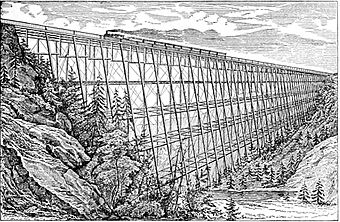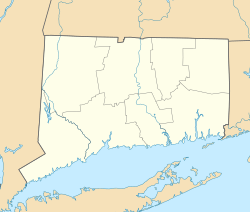Lyman Viaduct facts for kids
Quick facts for kids |
|
|
Lyman Viaduct
|
|
 |
|
| Location | Dickinson Creek and former Air Line RR right-of-way, Colchester, Connecticut |
|---|---|
| Area | 1 acre (0.40 ha) |
| Built | 1873 |
| Built by | Phoenix Iron Works |
| Architect | Serrell, Edward W., Air Line Railroad |
| NRHP reference No. | 86002729 |
| Added to NRHP | August 21, 1986 |
The Lyman Viaduct is a special railroad bridge built in 1873 in Colchester, Connecticut. It crosses over Dickinson Creek. This bridge is unique because it's a very old type of railroad bridge called a trestle, and it's made from a strong metal called wrought iron.
What makes the Lyman Viaduct even more special is that it was buried in sand! This happened because the railroad company, the New York, New Haven and Hartford Railroad, needed a stronger bridge for heavier trains. Instead of building a new one, they filled the old one with earth.
In 1986, the viaduct was added to the National Register of Historic Places. This means it's an important historical site. Today, the viaduct is part of the Air Line State Park Trail, which is a path for walking and biking.
Exploring the Lyman Viaduct
The Lyman Viaduct is in a quiet, natural area in Colchester. You can find it about half a mile west of Bull Hill Road, along the Air Line Trail. It's a very long bridge, about 1,112 feet (339 meters) in length. At its highest point, it stands about 137 feet (42 meters) tall.
This bridge was built using a special design called a "Post Truss" and was made from wrought iron. Imagine giant metal legs, called "bents," holding up the bridge. These bents were made from three curved pieces of wrought iron, joined together with rivets. Rivets are like strong metal pins that hold pieces of metal together.
At the spot where the stream flows, there are four tall columns, each about 30 feet (9 meters) high. All parts of the bridge were connected tightly, both side-to-side and across. Today, the entire structure is covered by dirt and cinder blocks. This makes it very strong, but also hides most of the original bridge.
History of the Viaduct
The Phoenix Iron Works company built the Lyman Viaduct in 1873. They built it for the Air Line Railroad. This railroad wanted to create a direct route for trains between New York City and Boston, Massachusetts.
Building the viaduct was a huge and expensive project for the railroad. The company faced many challenges and eventually stopped operating after only ten years. The New York, New Haven and Hartford Railroad then took over the line.
In the early 1900s, trains became much heavier. To make the viaduct strong enough for these new trains, the railroad decided to fill it with earth. This was a cheaper way to strengthen the bridge than building a brand new one. The train line continued to be used until the 1960s. After that, the state turned it into the Air Line Trail, a popular path for everyone to enjoy.
The Lyman Viaduct and another nearby bridge, the Rapallo Viaduct, are very important. They are among the first bridges in the world to be made from wrought iron. Because they were buried, they are still in good condition today. Other early wrought iron bridges, like the Verrugas Bridge in Peru, were washed away. The Kinzua Bridge in Pennsylvania was later rebuilt with steel.
Since we don't have all the records from when the Lyman Viaduct was built, studying it can teach us a lot. Scientists and historians might dig up parts of the buried bridge. This "forensic analysis" can help them learn how it was designed and built. It can also show if the builders changed anything from the original plans.
Images for kids





